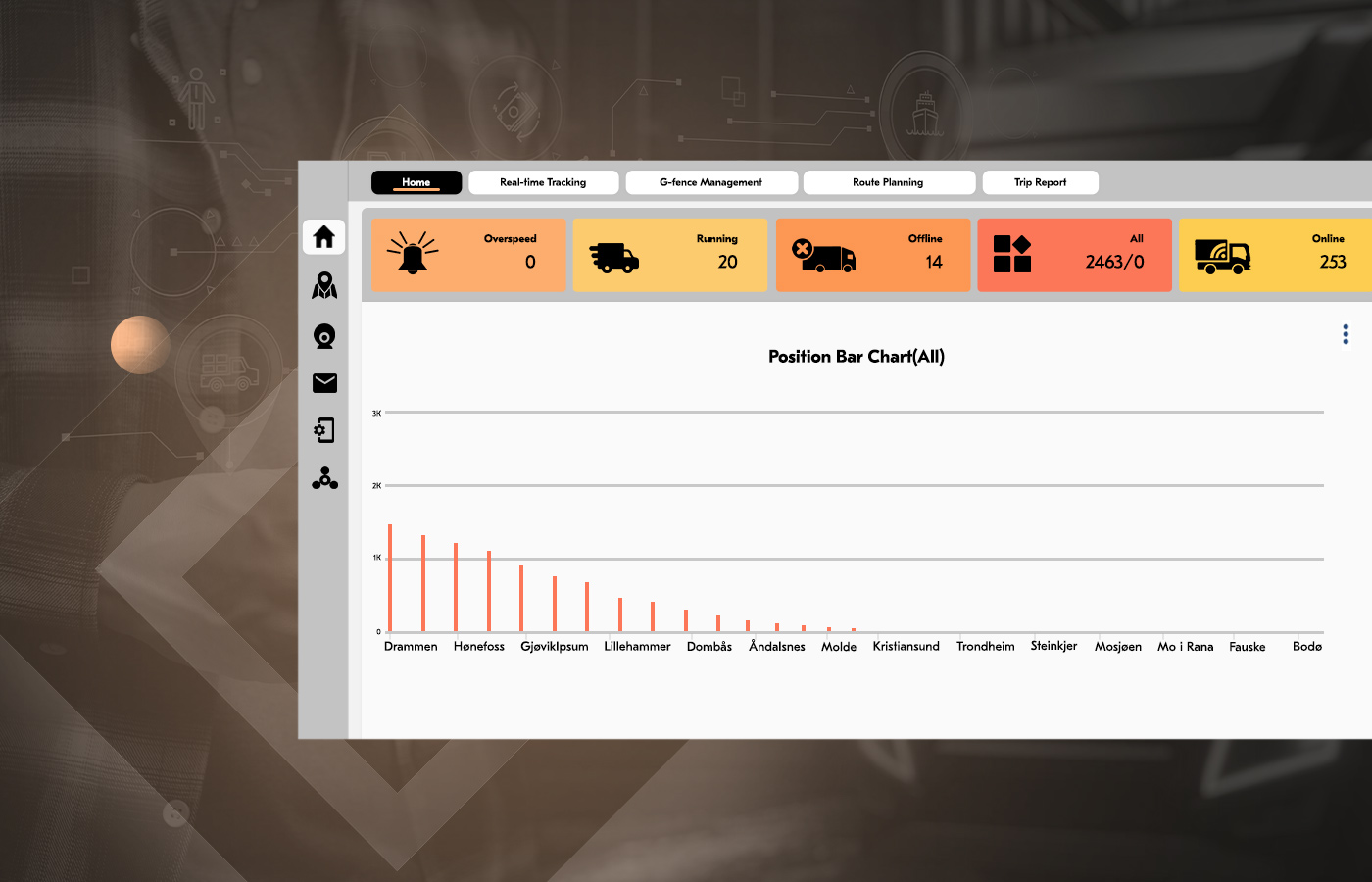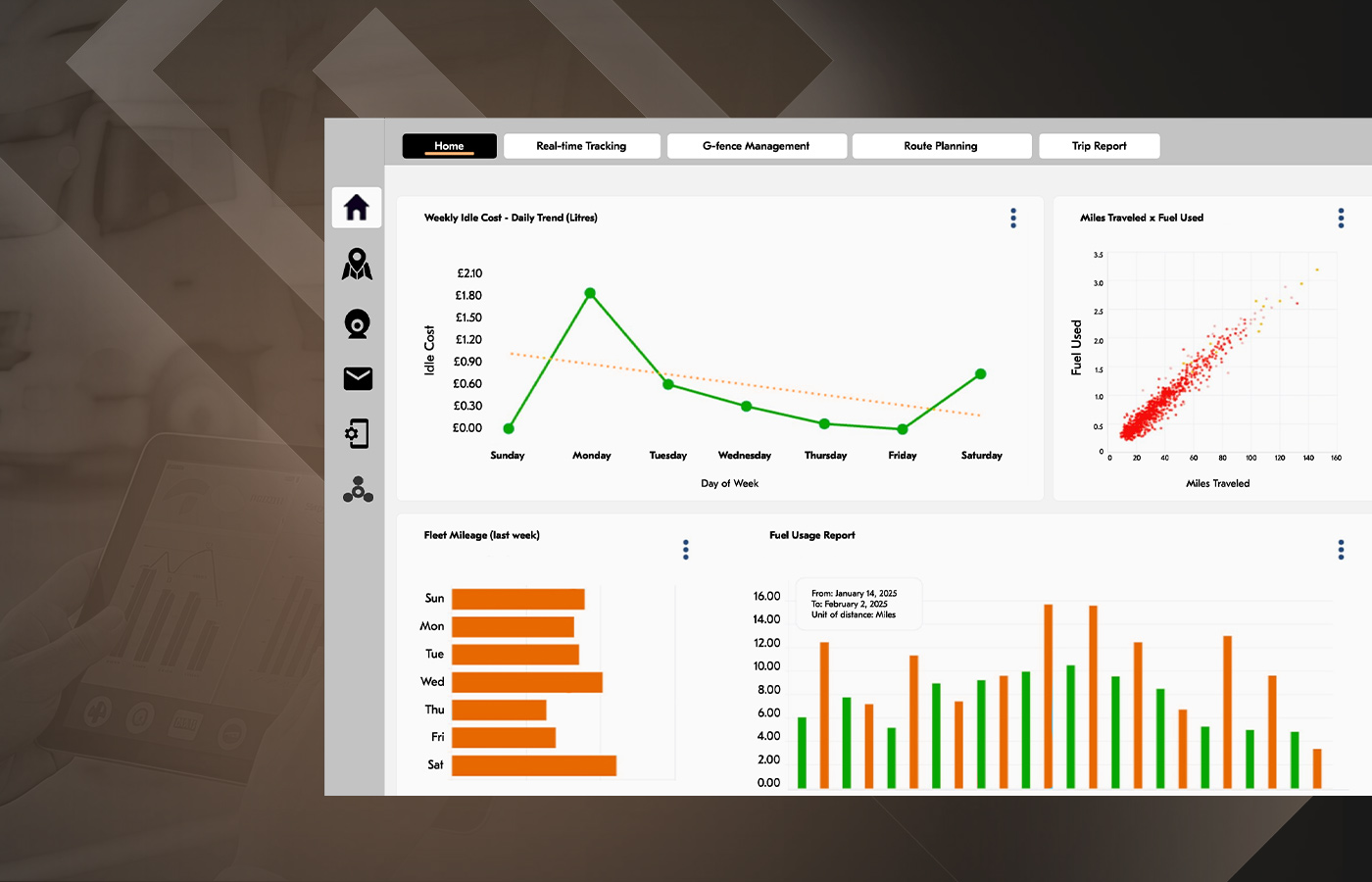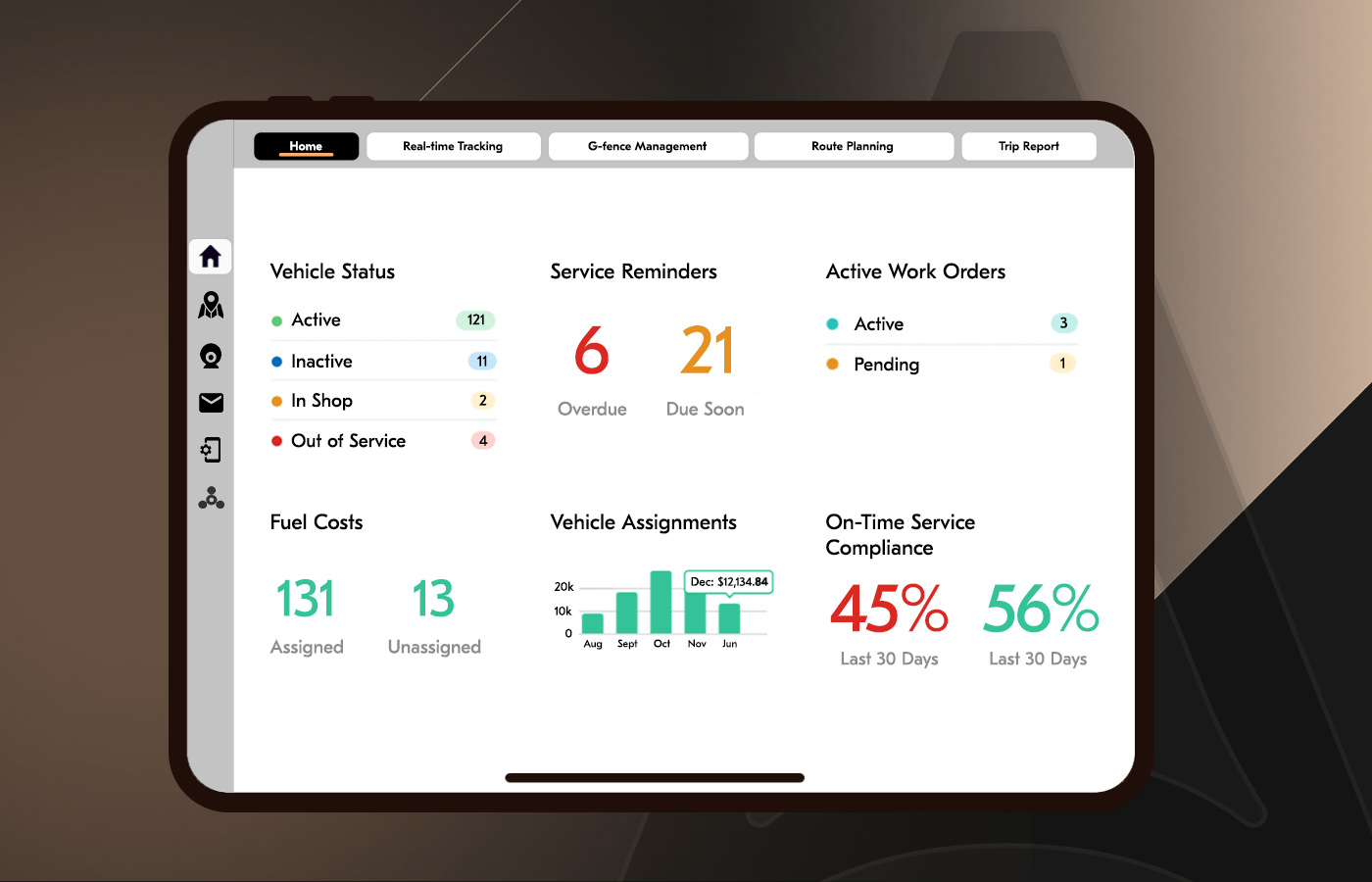

Carrier Software Modernization: A Web-Based Fleet Management System
- Legacy System Modernization
- IoT
- Audit
- Software Modernization
- Real-Time Solution
- Automation
Full-scale modernization for an outdated fleet management application. Adoption of real-time telematics, IoT integration, and data-driven dashboards for fleet visibility and efficiency. Addressing paper logs and disconnected systems into a streamlined, proactive management hub.
client
NDA Protected
Norway
200 employees
The client is a key freight carrier focused on long-haul transportation across Northern Europe. Their operations depend on tight coordination, strict fuel management, and minimal vehicle downtime to remain competitive and efficient in a volatile logistics market.
With growing pressure on margins and expanding demand, the company saw the need for a future-ready technology partner to prepare their workflows for operational growth. Thus, they approached Acropolium for fleet management solution modernization.
request background
Fleet Management Application Modernization: Audit for Future Visibility
The client's fleet management application was reliant on outdated infrastructure, since most processes were paper-based, with minimal data automation or real-time insights. Dispatchers managed operations using spreadsheets and manual check-ins, while maintenance teams lacked visibility into vehicle health between servicing appointments.
The fragmented system often resulted in missed preventative maintenance, inefficient route planning, and excessive fuel consumption. Unexpected disruptions regarding delivery timelines eventually inflated repair expenses. Also, the lack of centralization also made it difficult to scale operations as the fleet grew.
Acropolium was engaged to audit the current system, recommend a modern tech stack, and deliver a full-scope digital transformation of their fleet management platform. The goal was to implement a scalable, live-control web-based fleet management system to increase fleet uptime as the carrier operations expanded.
challenge
Addressing Fragmented Operations and Data Blind Spots
First of all, the absence of live tracking meant dispatchers had no real-time overview of fleet positions, making it difficult to adjust routes on the fly. Vehicle diagnostics also were not connected to the central system, so faults went unnoticed until they caused major failures.
When auditing for a modernized custom fleet management solution, we noticed that fuel tracking was based on driver estimates and handwritten logs, offering little insight into idling, route efficiency, or fuel waste. At the same time, maintenance schedules were manually tracked, often leading to missed servicing intervals and surprise repairs.
All key data, including vehicle performance, service logs, and driver reports, were housed in isolated tools that didn't communicate. This created blind spots and made comprehensive reporting impossible.
Scaling up the system posed serious risks, as the outdated architecture struggled under increased data loads. Reactive workflows meant the team was always responding to issues instead of preventing them.
Lastly, compliance documentation and audits became time-consuming due to scattered data sources — and our task was to centralize, automate, and optimize the fleet management application while providing learning instructions for the updated product.
goals
- Implement real-time GPS tracking and smart route optimization. The primary goal of fleet management system modernization was to provide dispatchers with instant visibility into vehicle locations and statuses, allowing for dynamic adjustments.
- Enable live vehicle diagnostics and detailed fuel-use analytics. Live data on engine health that would support proactive maintenance and more efficient fleet operation.
- Replace paper logs with a centralized digital dashboard, as a unified portal would ensure easy access to data for all departments.
- Seamlessly integrate telematics data and IoT sensor feeds. Unifying sensor inputs like cargo temperature and tire pressure into one system would enhance operational insight. This way, the web-based fleet management software could support predictive alerts and safety compliance.
- Build a scalable, cloud-hosted architecture ready for growth. A cloud-native solution would remove infrastructure bottlenecks and simplify expansion. It would also ensure system stability as the client added new vehicles or service areas.
- Train drivers and staff to adopt the new system quickly and efficiently. User adoption was critical to success, so training was built into the rollout.
solution
Real-time Powered & Transparent Custom Fleet Management Solution
Node.js, NestJS, TypeScript, PostgreSQL, Redis, WebSocket (Socket.IO), MQTT, React.js, React Native, Material-UI, Docker, Kubernetes, AWS (EC2, S3, RDS, CloudWatch, IoT Core), Grafana, Prometheus, Elasticsearch, BullMQ, RESTful APIs, OpenAPI/Swagger, JWT, OAuth 2.0
Ongoing
9 specialists
Our dedicated team began the project with a thorough audit of the client's existing infrastructure, including legacy software components, vehicle hardware interfaces, and operational workflows. For this fleet management system modernization, our assessment uncovered multiple inefficiencies, ranging from siloed data systems to paper-based records.
These constraints hindered daily operations and made it difficult for the client to scale or respond proactively to delivery challenges. Based on what our teams have found, we designed and implemented a modular fleet management platform built with a microservices architecture and deployed on AWS.
The new system was engineered to deliver high availability, seamless scalability, and end-to-end visibility of all fleet assets. We aimed to unify vehicle data, improve operational response times, and reduce the manual workload across dispatch, maintenance, and compliance functions.
To ensure alignment with the client's business processes, our team worked closely with internal stakeholders to map operational needs, define key fleet management system features, and plan for a phased rollout. We prioritized system stability, cloud readiness, and the ability to extend functionality as new technologies emerged.
The new platform consolidated fragmented tools into a unified environment. It replaced outdated manual workflows with automated processes while integrating real-time vehicle data and predictive diagnostics into everyday decision-making.
Data silos were broken down, live dashboards were introduced, and mobile accessibility was enabled for field teams and office staff alike. Additional features of the web-based fleet management software were implemented to support proactive fleet management, seamless IoT integration, and dynamic analytics. Here's how we approached the transformation:
- Interactive live maps for dispatchers with smart rerouting capabilities based on traffic, weather conditions, and delivery windows.
- OBD-II integration to collect engine health metrics in real time, including alerts for overheating, excess idling, or mileage irregularities.
- A centralized interface accessible to dispatchers, mechanics, and fleet managers; digital forms and automation replacing legacy paperwork and manual compliance checks.
- Sensor feeds from cargo temperature monitors, tire pressure systems, and vehicle load indicators fully integrated into the platform's workflows.
- Kubernetes-enabled infrastructure hosted on AWS, capable of scaling instantly to accommodate new vehicles, routes, or regional branches.
- Continuous telemetry streamed into Elasticsearch and Prometheus, visualized through Grafana dashboards to monitor performance trends and fleet health.
- Structured onboarding for drivers and operations teams, with ongoing Slack-based support and bi-weekly feedback cycles to optimize usability and engagement.
outcome
Automated, Data-First Custom Fleet Management Solution
- A 35% reduction in vehicle downtime driven by early fault detection, real-time diagnostics, and automated maintenance scheduling.
- Up to 20% projected savings in fuel costs as smart routing and live tracking features continue to scale across operational regions.
- A 50% decrease in paper-based processes, significantly improving data accuracy, accelerating internal workflows, and reducing administrative overhead.
client feedback
The team guided us through every step with clarity and care, making a complex change feel surprisingly smooth. We're already seeing the difference: fewer delays in the garage, clearer insight into fuel use, and a stronger sense that everything is finally running the way it should.
Related cases
Articles you may also like
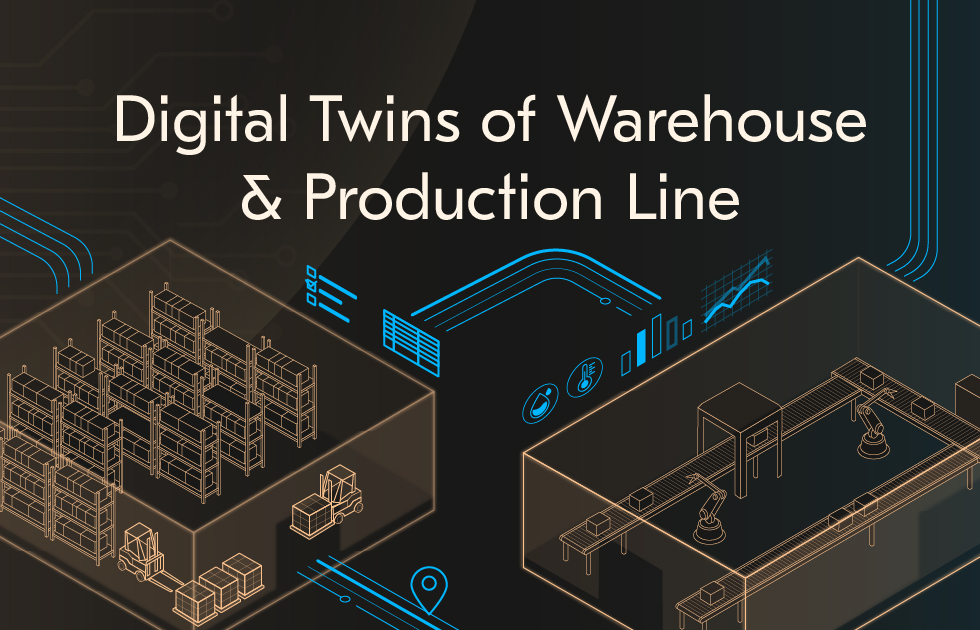
Digital twins of the warehouse and production line: modeling, telemetry and payback KPIs
![AI in Warehouse Management: [Benefits & Use Cases]](/img/articles/ai-in-warehouse-management/img01.jpg)
Why & How to Employ AI in Warehouse Management: Applications & Success Cases
![IoT for Supply Chain Businesses: [6 Use Cases Included]](/img/articles/iot-for-supply-chain-management/img01.jpg)
IoT for Supply Chain Management: Use Cases, Benefits & Real Examples
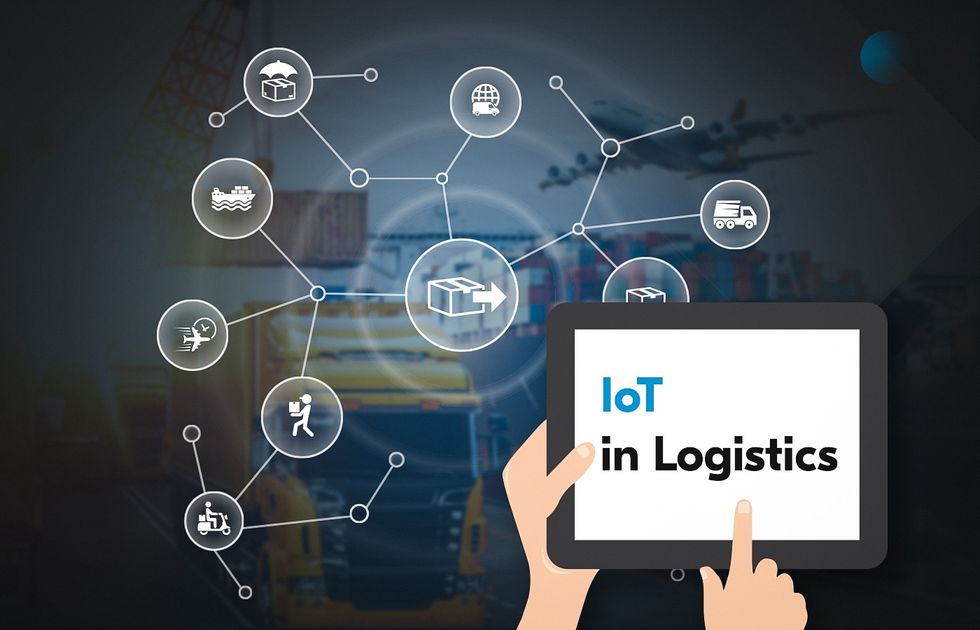
Embracing IoT in Transportation and Logistics to Boost Supply Chain Visibility
![ᐉ Airport Operations Management Solftware [2025 Guide]](/img/articles/airport-operations-management/img01.jpg)
Airport Operations Management Software to Modernize Your Business in 2025
![ᐉ Big Data in Logistics: Key Benefits [5 Real Use Cases]](/img/articles/big-data-in-logistics/img01.jpg)
Big Data in Logistics: Key Benefits & 5 Real Use Cases
![AI Route Planning in 2025: [Use Cases & Benefits]](/img/articles/ai-route-planning/img01.jpg)
AI Route Planning: Must-Have Automation & Optimization Practices in 2025
![ᐉ Mapbox vs. Google Maps [Choosing a Map API]](/img/articles/map-api/img01.jpg)
Mapbox vs. Google Maps: Choosing a Map API
![Machine Learning in Logistics and Supply Chain [7 Use Cases Included]](/img/articles/machine-learning-in-supply-chain-and-logistics/img01.jpg)
Adopting Machine Learning in Supply Chain and Logistics for Successful Automation
![Transport App Development [A 2025 Guide for Startups & Businesses]](/img/articles/transportation-app-development-guide/img01.jpg)
Transportation App Development Guide for Businesses: Benefits, Features & Case Studies
![ᐉ Blockchain in Logistics [Key Benefits & Real-Life Use Cases]](/img/articles/blockchain-implementation-in-logistics/img01.jpg)
Blockchain in Logistics: Key Benefits & Real-Life Use Cases
![Blockchain for Supply Chain Management: [Benefits & Use Cases]](/img/articles/why-and-how-to-employ-blockchain-in-supply-chain-management-tips-and-success-stories/img01.jpg)
Why and How to Employ Blockchain in Supply Chain Management (Tips & Success Stories)
![Generative AI in Supply Chain Management: [Use Cases & Solutions]](/img/articles/generative-ai-supply-chain-solutions/img01.jpg)
Investing in Generative AI Supply Chain Solutions: Use Cases & Challenges for 2025
![Predictive Analytics for Supply Chains in 2025: [Benefits & Applications]](/img/articles/predictive-analytics-in-supply-chains/img01.jpg)
Why Use Predictive Analytics in Supply Chains? Advantages, Use Cases & Solutions

Top Logistics Technology Trends Reshaping the Industry in 2025
![Fleet Fuel Management System [Complete Guide]](/img/articles/build-a-fuel-management-system/img01.jpg)
How to Build a Fleet Fuel Management System [Complete Guide]
![A Sustainability Transportation Guide: [Best Practices & Use Cases]](/img/articles/sustainable-transportation-practices/img01.jpg)
Sustainable Transportation Practices: Why Invest in Renewable Energy in 2025
![ᐉ Logistics Customer Portal Development: [2025 Guide]](/img/articles/logistics-customer-portal-development/img01.jpg)
Logistics Customer Portal Development: Step-by-Step Guide
![Transportation Telematics System: [Benefits, Challenges & Use Cases]](/img/articles/the-power-of-telematic-systems-in-transportation-benefits-challenges-and-use-cases/img01.jpg)
The Power of Telematic Systems in Transportation: Benefits, Challenges & Use Cases
![ᐉ Uber API Integration: [Step-by-Step Guide & Use Cases]](/img/articles/how-to-integrate-uber-api/img01.jpg)
Uber API Integration: A Complete Guide with 7 Benefits & Examples
![Big Data in Supply Chain: [9 Real Use Cases Included]](/img/articles/big-data-in-supply-chain-real-world-use-cases-and-success-stories/img01.jpg)
Big Data in Supply Chain: Real-World Use Cases and Success Stories
![6 Use Cases of AI in Transportation and Logistics: [2025 Edition]](/img/articles/ai-in-transportation/img01.jpg)
Use Cases of AI in Transportation & Logistics: Are They Relevant for Your Business?
![IoT in Fleet Management: [Use Cases, Trends & Case Studies]](/img/articles/employing-iot-for-fleet-management-benefits-use-cases-and-success-stories/img01.jpg)
Employing IoT for Fleet Management: Benefits, Use Cases & Success Stories
![Last-Mile Delivery Optimization: [Key Strategies in 2025]](/img/articles/last-mile-delivery-solutions-optimize-logistics-for-better-customer-satisfaction/img01.jpg)
Last-mile Delivery Solutions: Optimize Logistics for Better Customer Satisfaction
![Load Planning Software: [Features, Types and Benefits]](/img/articles/load-planning-software-features-types-and-benefits/img01.jpg)
Load Planning Software: Features, Types and Benefits
How to Develop a GPS Tracking Software for Real-time Vehicle Tracking
![Best Trucking Software in 2025: [Custom or Off-The-Shelf]](/img/articles/best-trucking-software-to-consider-custom-vs-off-the-shelf/img01.jpg)
Best Trucking Software to Consider in 2025: Custom vs Off-the-Shelf
![Multi-Carrier Shipping Software: [8 Use Cases & Key Benefits]](/img/articles/multi-carrier-shipping-software-a-guide-to-enhancing-shipping-efficiency/img01.jpg)
Multi-Carrier Shipping Software: a Guide to Enhancing Shipping Efficiency

How to Build Custom Fleet Management and Maintenance Software
![Transportation Management Software Development [2025 Guide]](/img/articles/transportation-software/img01.jpg)
Transportation Management Software Development — A Detailed Overview
![How to choose the Best Transportation Management Software [2025 Guide]](/img/articles/best-transportation-management-software/img01.jpg)
How to Choose the Best Transportation Management Software: Custom vs. Off-the-Shelf
![Warehouse Automation Systems [8 Benefits for Your Business]](/img/articles/warehouse-automation-systems/img01.jpeg)
Warehouse Automation Systems: Technologies Taking Warehousing to the Next Level

How to develop a logistics document management system (case study included)

3PL Warehouse Management System: Why Choose a Custom SaaS WMS for Your Warehouse
![Supply Chain Analytics Software [Key Features & Use Cases]](/img/articles/supply-chain-analytics-software/img01.jpg)
Employing Supply Chain Analytics Software for Efficient Workflows — Key Features & Use Cases
![The Best Route Optimization Software to Employ in [2025]](/img/articles/route-optimization-software/img01.jpg)
Custom vs. Off-the-Shelf Route Optimization Software: Which Serves You Best?
![Logistics & Shipping APIs Integration Guide [2025]](/img/articles/logistics-and-shipping-apis/img01.jpg)
A Guide to Integrating Logistics and Shipping APIs to Optimize Your Supply Chain Business
![Best Truck Dispatching Software to Consider in [2025]](/img/articles/best-trucking-dispatching-software/img01.jpg)
Best Trucking Dispatching Software in 2025: Custom vs Off-the-Shelf
![Cloud Computing in Logistics and Supply Chain [2025 Guide]](/img/articles/cloud-computing-in-logistics-and-supply-chain/img01.jpg)
Cloud Computing in Logistics and Supply Chain: Use Cases Included
![ᐉ Warehouse Management Systems Development [2025 Guide]](/img/articles/warehouse-management-systems/img01.jpg)
Warehouse Management Systems Development: Empowering Real-Time Tracking and Visibility

Chatbots in Logistics & Transportation: Benefits & Use Cases

Logistics & Transportation Software Modernization: Best Practices and Lessons Learned

How Software for Freight Brokers Increases Business Efficiency and Profitability: Real-World Examples

Logistics App Development: Building a Product That Will Help Your Business
![Logistics Management System [2025 Guide]: Use Cases Included](/img/articles/logistics-management-system/img01.jpg)
Why A Logistics Management System Is A Must For Successful Supply Chain Operations

Supply Chain Management Software System: Its Features, Benefits, and How to Integrate a Suitable One

How to Turn Custom Freight Forwarding Software to Your Advantage
![Shipping Management System Development ☑️ [2025 Guide]](/img/articles/shipping-management-system/img01.jpg)
How to Automate the Shipping Process with a Shipping Management System

Guide of How to Integrate e-AWB for a Freight Forwarder

Why It Pays to Build Dispatch Management Software

How to Build Vehicle Routing Software to Earn More and Drive Less?

EDI in Logistics: How to Develop EDI Software to Make an E-Switch?


